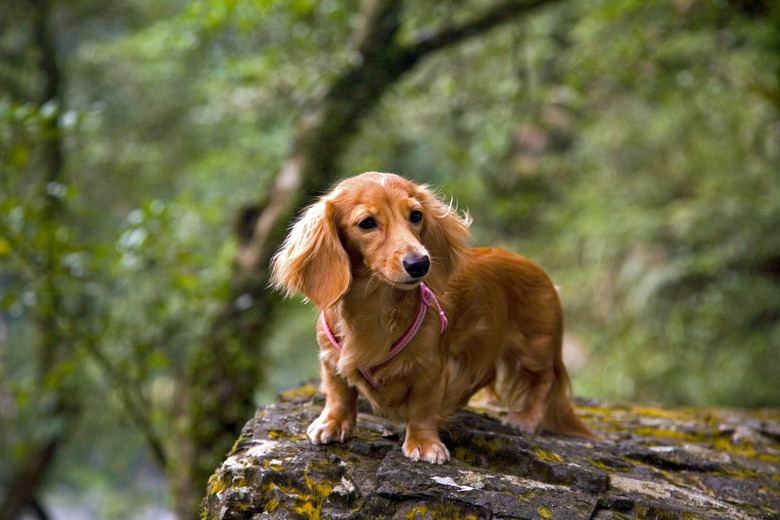Long Haired Dachshund: Characteristics, Temperament & Puppies
We may receive a commission on purchases made from links.
Dachshunds are the perfect companions for those who want a dog to make them smile, both from their cute appearance and behavior. The telltale dachshund characteristics such as a long body and friendly, alert expression make them a joy to have in your household.
These courageous pups were bred in Germany with the purpose of extracting badgers from their underground dens. Their long, narrow bodies are ideals for entering burrows and their tenacious temperament makes them effective hunters. However, with the proper care and exercise schedule, these small hounds make excellent companions and lapdogs.
Longhaired dachshund characteristics
Longhaired dachshund characteristics
A member of the American Kennel Club's hound group, dachshunds are easily recognizable by their short stature and long bodies. They have moderately long, rounded ears and a long muzzle that is slightly arched on top. These dachshund characteristics are the same for all dogs of this breed, whether they have a smooth, wirehair, or longhair coat.
Longhaired dachshunds have a sleek, shiny coat that is shorter on their backs and longer hair on the ears, neck, chest, back of the legs, and underside of the body. The hair may be slightly wavy. Dachshunds come in a variety of colors including black and tan, cream and red.
The AKC recognizes two sizes of dachshunds: standard and miniature. Standard dachshunds are 8 to 9 inches tall and weigh 16 to 32 pounds. Miniature dachshunds are 5 to 6 inches tall and weigh up to 11 pounds. (Note, you might see their name spelled as long haired "doxen," which is how the word sounds, but that isn't how their name is officially spelled).
Longhaired dachshund temperament & training
Longhaired dachshund temperament & training
Breed is not a reliable indicator of personality, however, dachshunds are known for their clever and courageous temperament. They are not shy dogs, but rather have a friendly and curious nature. They are alert and responsive to commands and have agreeable personalities. However, this is combined with an independent attitude and a stubborn streak that can make training a challenge.
As hounds, they have a strong prey drive, so holding their attention can be a challenge in some situations. They also tend to be sensitive and affectionate, so focus on consistency and providing positive reinforcement during the training process. Socialization with other dogs and humans of all ages is important starting at a young age.
Longhaired dachshund grooming
Longhaired dachshund grooming
Longhaired dachshunds need daily brushing to keep their coat healthy and free of tangles. Do not shave longhaired dachshunds but give them a trim as needed. Bathe them first and then use scissors with a rounded tip to trim the ears, face, paws, and tail. If your dachshund won't stay still, take him to a groomer or ask for help to avoid accidentally cutting him during a trim. Trim their nails about once per month.
Longhaired dachshund exercise & health
Longhaired dachshund exercise & health
Dachshunds have a medium energy level and need regular exercise to stay happy and healthy. Maintaining a healthy weight and strong muscles are important for supporting the dog's long back. Walk the longhaired dachshund twice per day or consider participating in activities such as field or earthdog trails where they have the opportunity to track rabbits or rats.
The breed is generally healthy and has a lifespan of 12 to 16 years. They are prone to back injuries and ear infections. Responsible breeders will perform the recommended health tests to ensure puppies don't have common conditions. These include an exam for patella luxation, an eye examination, and a cardiac exam to rule out congenital heart disease.
Longhaired dachshund puppies
Longhaired dachshund puppies
Dachshund puppies grow quickly until they reach six months of age. At three months, a standard dachshund may weigh 7 to 14 pounds and grow to reach 11 to 25 pounds by six months. A mini dachshund weighs 5 to 6 pounds at three months and 8 to 9 pounds at six months. The dogs continue to grow at a slower rate until they reach their full size between nine and 12 months of age.
The color genetics of dachshunds can be a bit complicated, but some colors are rarer because they are recessive traits. For example, a chocolate long-haired dachshund has two recessive B-series genes, while a black dachshund has one or two dominant genes. A cream long-haired dachshund has the Chinchilla or albino gene. Cream dachshunds may be English cream, which means they are born with black fur and over time, the cream-colored fur emerges, or they may be true, or ee, creams, which means they are born with cream-colored fur.
References
- Dachshund Club of America: Breed Standard
- Dachshund World: Grooming Tips for You and Your Dog
- Dachshund Club of America: Development of the Dachshund
- American Kennel Club: Dachshund
- Dachshund Club of America: Official Breed Club Health Statement.
- AKC: Earthdog Trails
- Reeds Mini Dachshunds: Dachshund Genetics – Color, Coat and Pattern
